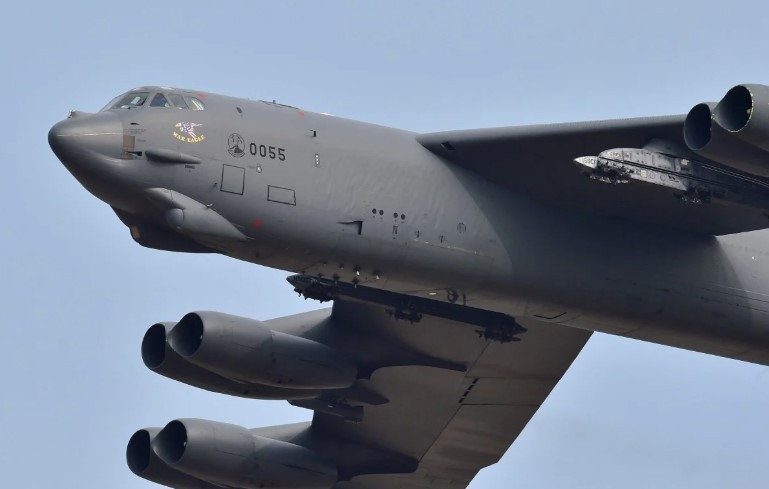A recent Chinese military research paper has spotlighted an unexpected threat in the evolving U.S.-China strategic rivalry: the Boeing B-52 Stratofortress.
Chinese Study Names B-52 as Major Threat Despite Its Age
Despite being designed in the 1950s, this American bomber has been identified as the most significant danger to China in a potential tactical nuclear conflict. The results were published in Modern Defence Technology, a prestigious Chinese defense publication, and were derived from a simulation carried out by researchers at the People’s Liberation Army (PLA) Air Force Early Warning Academy in Wuhan.
The U.S. Air Force conducted a “penetrating counterair operation” on Chinese naval fleets and interior military objectives during the scenario. The results suggested that the B-52 remains central to American power projection, capable of launching long-range, precision-guided weapons—including nuclear warheads—from secure bases far outside China’s defensive perimeter.
This analysis is raising questions in global defense circles. Why would Chinese strategists prioritize a non-stealthy, Cold War-era bomber over modern platforms like the F-22 Raptor or the stealthy F-35 Lightning II? The answer lies in the B-52’s range, payload, and its ability to operate independently of vulnerable forward bases.
PL-15 Missile Combat Confirmed China Unleashes Powerful Weapon in Real Battle
Payload, Range, and Survivability: The Durable Advantage of the B-52
Eight TF33 turbofan engines power the still-in-service B-52H variant, which has a combat range of almost 8,800 miles without the need for aerial refueling. This enables it to function from far-off bases that are thought to be safe from Chinese missile strikes, such as Diego Garcia or Andersen AFB in Guam. The bomber can launch anything from conventional JDAMs to nuclear-capable AGM-86B cruise missiles with a standoff range of more than 1,500 miles, and it can carry up to 70,000 pounds of ordnance.
China has spent billions modernizing its defenses, acquiring S-400 missile systems and deploying its own HQ-9 batteries. Yet, the B-52’s ability to fire low-flying cruise missiles from beyond the reach of these systems presents a troubling loophole in China’s air defense shield. The study suggests that the bomber’s capacity to deliver sudden, deep strikes without entering heavily contested airspace makes it especially formidable.
The aircraft’s operational dependability is further demonstrated by its endurance and track record in American engagements, including those in Vietnam, Afghanistan, and the South China Sea. Particularly to allies like Japan and the Philippines, its recent participation in freedom of navigation missions close to contested areas serves as an outward demonstration of American military might.
When compared to stealth aircraft, the threat posed by the B-52 is much more obvious. The B-52’s range and payload are better than those of the F-22 and F-35, despite their improved penetration capabilities. These fighters must operate from bases that China could strike with precision missiles, diminishing their strategic reliability in a drawn-out conflict.
Eyes on the Wreckage: China’s Mach 5 Missile PL-15E Becomes Intelligence Jackpot for West and Allies
Strategic Anxiety and the Symbolism of the B-52
China’s nuclear doctrine, built on a no-first-use policy and second-strike credibility, finds itself challenged by the capabilities of the B-52. The bomber’s nuclear loadouts and standoff attack profile raise concerns that it could disable China’s retaliatory capacity before it is deployed. Chinese analysts seem particularly worried about scenarios involving low-yield tactical nuclear weapons—scenarios increasingly discussed in U.S. military circles.
This anxiety is further amplified by the broader geopolitical environment. The U.S. continues to strengthen its Indo-Pacific alliances while expanding military cooperation with countries like Australia and the Philippines. Simultaneously, China has increased its presence in the South China Sea and conducted military maneuvers around Taiwan. These actions set a tense backdrop for Chinese planners, who see the B-52 as a key component of any future U.S. campaign to neutralize China’s deterrent.
Despite China’s investment in systems like hypersonic missiles and anti-satellite weapons, these technologies remain in developmental phases. In contrast, the B-52 has been proven in combat, is dependable, and has already been incorporated into a network-centric U.S. warfare doctrine that encompasses electronic warfare, satellite communication, and AWACS coordination.
Chinese Jets Outgun French Rafales in India-Pakistan War—Indonesia Reconsiders $8B Deal
It’s interesting to note that the study’s emphasis on the B-52 rather than the more covert B-2 or the soon-to-be B-21 Raider may be due to psychological as well as tactical considerations. In terms of American strategy, the Stratofortress stands for consistency, tenacity, and predictability. Its longevity may make it an easier reference point for simulations and policy development than newer, less-deployed platforms.
Ultimately, the PLA’s concern about the B-52 is not just about a single aircraft—it’s about what the bomber represents: long-range, high-volume, survivable strike capability. And for now, it remains a symbol of American airpower that China cannot afford to ignore.

